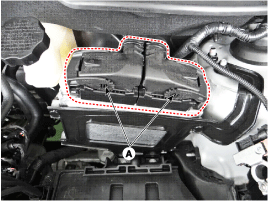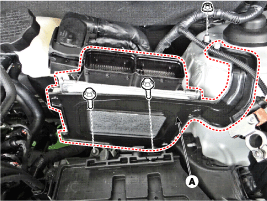Hyundai Tucson: Automatic Transaxle Control System / Transaxle Control Module (TCM) Repair procedures
| Replacement |
| 1. |
Turn ignition switch OFF. |
| 2. |
Disconnect the negative (-) battery cable. |
| 3. |
Remove the battery.
(Refer to Engine Electrical System - "Battery") |
| 4. |
Disconnect the TCM extension connector (A).
|
| 5. |
Remove the TCM (A) after removing the mounting bolts and nut.
|
| Inspection |
| 1. |
TEST TCM GROUND CIRCUIT: Measure resistance between TCM and
chassis ground using the backside of TCM harness connector as TCM side
check point. If the problem is found, repair it.
|
| 2. |
TEST TCM CONNECTOR: Disconnect the TCM connector and visually
check the ground terminals on TCM side and harness side for bent pins
or poor contact pressure. If the problem is found, repair it. |
| 3. |
If problem is not found in Step 1 and 2, the TCM could be
faulty. If so, make sure there were no DTC's before swapping the TCM
with a new one, and then check the vehicle again. If DTC's were found,
examine this first before swapping TCM. |
| 4. |
RE-TEST THE ORIGINAL TCM: Install the original TCM (may be
broken) into a known-good vehicle and check the vehicle. If the problem
occurs again, replace the original TCM with a new one. If problem does
not occur, this is intermittent problem (Refer to “Intermittent
Problem Inspection Procedure” in Basic Inspection Procedure).
|
| Installation |
| 1. |
Install in the reverse order of removal.
|
 Transaxle Control Module (TCM) Schematic Diagrams
Transaxle Control Module (TCM) Schematic Diagrams
1. TCM Connector and Terminal Function
2. TCM Terminal Function
Connector [A]
PinDescriptionPinDescription1-54-2-55-3-56-4-57-5-58Sport mode down switch6-59Oil temperature sensor (+)7-60-8-61-9-6 ...
 Transaxle Oil Temperature Sensor Description and Operation
Transaxle Oil Temperature Sensor Description and Operation
Description
Transmission Oil Temperature Sensor monitors the automatic
transmission fluid's temperature and conveys the readings to TCM. It is
an NTC (Negative Thermal Coefficient) sensor whose ...
Other information:
Hyundai Tucson (LM) 2010-2015 Service Manual: Accelerator Position Sensor (APS) Description and Operation
Description
Accelerator Position Sensor (APS) is installed on the
accelerator pedal module and detects the rotation angle of the
accelerator pedal. The APS is one of the most important sensors in
engine control system, so it consists of the two sensors which adapt
individual sensor power ...
Hyundai Tucson (LM) 2010-2015 Service Manual: Propeller Shaft Repair procedures
Removal
1.
After making a match mark on the flange yoke and transaxle companion, remove the propeller shaft mounting bolts (A).
Tightening torque:
49.0 ~ 68.6 N.m (5.0 ~ 7.0 kgf.m, 36.1 ~ 50.6 lb-ft)
2.
Remove the center bearing bracket (A) mounting bolts (B-2ea).
Tightening to ...



